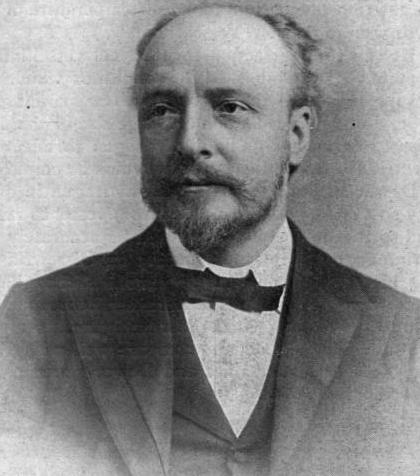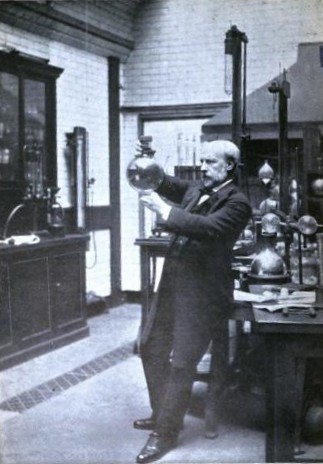<Back to Index>
- Chemist Sir James Dewar, 1842
- Architect Giacomo Quarenghi, 1744
- King of Siam Rama V, 1853


Sir James Dewar FRS (20 September 1842 – 27 March 1923) was a British chemist and physicist. He is probably best-known today for his invention of the Dewar flask, which he used in conjunction with extensive research into the liquefaction of gases. He was also particularly interested in atomic and molecular spectroscopy, working in these fields for more than 25 years.
James Dewar was born in Kincardine-on-Forth in 1842, the youngest of six boys. He lost his parents at the age of 15. He was educated at Dollar Academy and the University of Edinburgh, where he studied under Lord Playfair, and later became Lord Playfair's assistant. Dewar would also study under August Kekulé at Ghent.
In 1875, Dewar was elected Jacksonian professor of natural experimental philosophy at the University of Cambridge, becoming a fellow of Peterhouse. He became a member of the Royal Institution and later, replaced Dr. John Hall Gladstone in the role of Fullerian Professor of Chemistry in 1877. Dewar was also the President of the Chemical Society in 1897 and the British Association for the Advancement of Science in 1902, as well as serving on the Royal Commission established to examine London's water supply from 1893 to 1894 and the Committee on Explosives. It was whilst he was serving on the Committee on Explosives that he and Frederick Augustus Abel developed cordite, a smokeless gunpowder alternative.
In 1867 Dewar described several chemical formulae for benzene. Ironically, one of the formulae, which does not represent benzene correctly and was not advocated by Dewar, is sometimes still called Dewar benzene.
His scientific work covers a wide field - his earlier papers cover a wide range of topics; organic chemistry, Hydrogen and its physical constants, high temperature research, the temperature of the sun and of the electric spark, electro-photometry and the chemistry of the electric arc.
With Professor J.G. McKendrick, of Glasgow, he investigated the physiological action of light, and examined the changes which take place in the electrical condition of the retina under its influence. With Professor G.D. Living, one of his colleagues at Cambridge, he began in 1878 a long series of spectroscopic observations,
the later of which were devoted to the spectroscopic examination of
various gaseous elements separated from atmospheric air by the aid of
low temperatures; and he was joined by Professor J.A. Fleming, of University College London, in the investigation of the electrical behaviour of substances cooled to very low temperatures. His name is most widely known in connection with his work on the liquefaction of the so-called permanent gases and his researches at temperatures approaching absolute zero.
His interest in this branch of physics and chemistry dates back at
least as far as 1874, when he discussed the "Latent Heat of Liquid
Gases" before the British Association. In 1878 he devoted a Friday
evening lecture at the Royal Institution to the then recent work of Louis Paul Cailletet and Raoul Pictet,
and exhibited for the first time in Great Britain the working of the
Cailletet apparatus. Six years later, again at the Royal Institution,
he described the researches of Zygmunt Florenty Wróblewski and Karol Olszewski, and illustrated for the first time in public the liquefaction of oxygen and
air. Soon afterwards he built a machine from which the liquefied gas
could be drawn off through a valve for use as a cooling agent, before
using the liquid oxygen in research work related to meteorites; about
the same time he also obtained oxygen in the solid state. By
1891 he had designed and built, at the Royal Institution, machinery
which yielded liquid oxygen in industrial quantities, and towards the
end of that year he showed that both liquid oxygen and liquid ozone are
strongly attracted by a magnet. About 1892 the idea occurred to him of
using vacuum-jacketed vessels for the storage of liquid gases - the
Dewar flask (otherwise known as a Thermos or vacuum flask)
- the invention for which he became most famous. The vacuum flask was
so efficient at keeping heat out that it was found possible to preserve
the liquids for comparatively long periods, making examination of their
optical properties possible. Dewar did not profit from the widespread
adoption of his vacuum flask - he lost a court case against Thermos
concerning the patent for his invention. While Dewar was recognised as
the inventor, because he did not patent his invention there was no way
to stop Thermos from using the design. He next experimented with a high pressure hydrogen jet by which low temperatures were realized through the Joule–Thomson effect, and the successful results he obtained led him to build at the Royal Institution a large regenerative cooling refrigerating machine. Using this machine in 1898, liquid hydrogen was collected for the first time, solid hydrogen following in 1899. He tried to liquefy the last remaining gas, Helium, which condenses into a liquid at −268.9°C, but owing to a number of factors, including a lack of Helium with which to work, Dewar was preceded by Heike Kamerlingh Onnes as the first person to produce liquid helium, in 1908. Onnes would later be awarded the Nobel Prize in Physics for
his research into the properties of matter at low temperatures - Dewar
was nominated several times but never successful in winning the Nobel
Prize. In 1905 he began to investigate the gas-absorbing powers of charcoal when
cooled to low temperatures, and applied his research to the production
of high vacuums, which were useful for further experiments in atomic
physics. Dewar would continue his research work into the properties of
elements at low temperatures, specifically low-temperature calorimetry, until the outbreak of World War I.
The Royal Institution laboratories lost a number of staff to the war
effort, both in fighting and scientific roles, and after the war, Dewar
had little interest in re-starting the serious research work which went
on before the War. Shortages of scholars necessarily compounded the
problems. His research during and after the war mainly involved
investigating surface tension in soap bubbles, rather than further work into the properties of matter at low temperatures. Whilst Dewar was never recognised by the Swedish Academy, he was recognised by many other institutions both before and after his death, both in Britain and overseas; The Royal Society bestowed
their Davy, Copley and Rumford medals upon him for his work, in 1899 he
became the first recipient of the Hodgkins gold medal of the Smithsonian Institution, Washington, for his contributions to our knowledge of the nature and properties of atmospheric air. In
1904 he was the first British subject to receive the Lavoisier medal of
the French Academy of Sciences, and in 1906 he was the first to be
awarded the Matteucci medal of the Italian Society of Sciences. He was
knighted in 1904 and awarded the Gunning Victoria Jubilee Prize for
1900-1904 by the Royal Society of Edinburgh, and in 1908 he was awarded the Albert medal of The Society of Arts. A lunar crater has been named in his honor. James
Dewar died in London in 1923, still holding the office of Fullerian
Professor of Chemistry at the Royal Institution, having refused to
retire. He was cremated at the Golders Green Crematorium where his ashes remain.